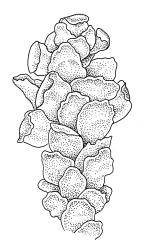- = Hepaticina Müll.Hal., Hedwigia 41: 124 (1902) nom. inval.
Plants medium-sized to robust, rather rigid, often darkening upon drying, forming loose turves. Stems erect, sparsely branched, complanate, in cross-section with a central strand, beset below with red-brown, smooth rhizoids. Leaves inserted in 8 ranks, often pale, those in dorsal and ventral ranks symmetric or nearly so, those in lateral ranks markedly asymmetric, especially at base, with broadly rounded or ± acute apices, plane, entire to coarsely and irregularly toothed; upper laminal cells round-hexagonal in outline, thin- or thick-walled, ± thickened at corners, the exposed (abaxial and adaxial) walls very thin and collapsing when dry. Costa single, often unevenly bifurcate. Gemmae often present on intramarginal cells, usually branched. Pseudoparaphyllia present, foliose.
Dioicous. Perichaetial leaves lacking costae and border. Perigonia globose to ovoid, scattered on main stems, with broadly ovate, obtuse, strongly concave, and ecostate bracts and numerous filiform paraphyses. Setae lateral, erect, arcuate at apex, smooth, in cross-section lacking a hyaloderm, twisted weakly to the left throughout, dark red-brown; capsules pendent, symmetric, smooth when dry, pale to dark yellow-brown; exothecial cells oblong to ± isodiametric, firm-walled, collenchymatous; annulus well-developed, falling with the operculum. Exostome teeth yellow-brown, linear-lanceolate, deeply furrowed for c. ⅔ their length, cross-striate to apex of furrow, baculate-papillose near tip, with high lamellae on inner surface that project laterally as strong marginal trabeculae; endostome pale yellow, with a high basal membrane and well-developed and keeled segments; cilia absent. Calyptra mitrate, enclosing only the operculum. Spores small, smooth.
Achrophyllum is a small genus restricted to temperate regions in the southern hemisphere. While Brotherus (1925, p. 234, as Pterygophyllum Brid.) placed the number of species at 32, this number is certainly inflated. Streimann (1997) suggested that a more accurate number might be about eight species, "most from southern South America". However, as some of the South American taxa are probably taxonomic synonyms of Australasian species, even Streimann’s estimate of the genus size is probably too large.
Vitt & Crosby (1972) demonstrated that the commonly used Pterygophyllum Brid. is illegitimate and described the new genus Achrophyllum for Pterygophyllum in the 1907 sense of Brotherus (1901–1909, p. 931).
| 1 | Leaves often strongly crisped when dry and not reviving readily when moistened; leaf margins irregularly dentate (some teeth often multi-cellular) in upper half or more, not obviously bordered when dry; upper laminal cells (at level of costa terminus) (45–)54–75(–90) µm in greater diam. | A. dentatum |
| 1' | Leaves not strongly crisped when dry and reviving readily when moistened; leaf margins entire or minutely and evenly toothed (teeth never multi-cellular) in upper portions, usually appearing thickened at margins when dry (due to one or more rows of thick-walled, small cells); upper laminal cells (at level of costa terminus) larger, 60–150 µm in greater diam. | A. quadrifarium |
| Category | Number |
|---|---|
| Indigenous (Endemic) | 1 |
| Indigenous (Non-endemic) | 1 |
| Total | 2 |
Achrophyllum and Pterygophyllum
Hepaticina zuerniana Müll.Hal. nom. inval. and H. parvula Müll.Hal. nom. inval. were published in Hedwigia (vol. 41, 1902). The genus Hepaticina is invalid. Both names were synonymised by Dixon (1927, p. 288) with Pterygophyllum dentatum. Hepaticina zuerniana has two N.Z. syntypes (collected by G. Zürn at Coromandel and R. Helms at Greymouth). Hepaticina parvula is also based on two syntypes, one from Victoria and the other an F.M. Reader collection from an unspecified North I. locality. None of these four syntypes have been studied for this treatment. Dixon "examined the types of [the] various species described by C. Mueller" and referred them to Pterygophyllum dentatum. Little purpose would be served by questioning Dixon’s synonymy and these names are not discussed further here.
Hookeria spp. There are five names coined by Colenso in the genus Hookeria and treated by Dixon (1927, p. 288–289) as synonyms of either Pterygophyllum dentatum or P. dentatum var. robustum. These Colenso names are Hookeria curviseta, H. obtusata, H. ramulosa, H. subsimilis, and H. telmaphila. Their types were all gathered near Norsewood (Hawke’s Bay L.D.), and all were published in the Transactions and Proceedings of the New Zealand Institute. No appropriate type material under these names can be located in BM and it is likely that Dixon referred to the protologues rather than specimens in proposing their synonymy. However, little purpose would be served by questioning Dixon’s synonymy and these names are not discussed further here.
Hookeria flava Colenso is a synonym of Distichophyllum pulchellum, q.v.




